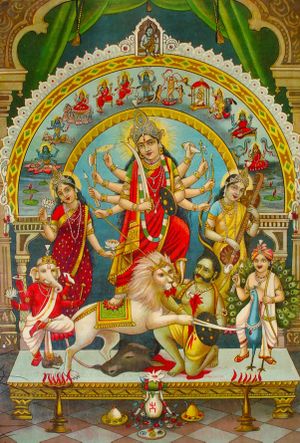Devi

Devi (Sanskrit: f., देवी devī "goddess") is a Hindu goddess. She plays a role particularly in Shaktism as Shakti and, as Mahadevi (great goddess), is regarded as the only goddess who unites all other goddesses in herself, for all goddesses accordingly appear only as manifestations of Devi's different natures. Her forms are manifold: thus she appears as Lakshmi, Sarasvati, Durga, Kali and Parvati or as the ten Mahavidyas.
The first written source that reports Devi as the supreme being and all-goddess is a 6th century Purana, the Devi Mahatmya ("Praise of the Goddess"). In the Lalita Sahasranama, the goddess appears under many names, such as "root of existence" (Jagatikanda), "She who transcends the universe" (Vishvadika) or "She whom nothing equals" (Nirupama).
Devi is considered the creator and controller of the universe, she is the creative aspect of the Absolute (Brahman) and universal mother. Thus she is also called "Mata", mother. Devi is seen as an active force (Shakti) that manifests itself as the universe. She is the primordial cause and root of existence and existence itself and in this function also Maya. She is seen as the highest reality and in this form is an active, creative and transcendent force. In some cults and myths she towers above the male gods, is considered superior to them and the highest manifestation of the absolute, absolute reality and absolute truth. In these myths, Devi is the primordial force from which the male gods receive instructions to create or destroy.
In the Devi-Bhagavata Purana she is described as the all-goddess as follows: "It is only your power with which Brahma creates, with which Vishnu sustains and with which Shiva in the end destroys the universe again. Therefore, without your intervention they would be powerless and for this reason you alone are the creator, sustainer and destroyer of the world."
Devi in mythology
Devi's central role in mythology is that of creator and queen of the universe. She is usually described as a beautiful young woman sitting on a throne in the highest heaven surrounded by thousands of subjects. In one myth, the feet of Devi's throne are the four male Hindu gods, just as in most myths they appear as Devi's creatures. As the queen of the myriad universes and innumerable Brahmas, Shivas and Vishnus that emerge from her, Devi's function is to create, preserve and destroy. It is said that the world is destroyed when Devi closes her eyes and rises again when she opens her eyes. Although she is the queen of the universe, Devi also takes an active role in it by protecting the world, maintaining cosmic order and providing shelter and nourishment to her creatures. However, despite her function as a great mother, she often appears as a warrior as well. In this form she is identified with Durga.
Besides her warrior and benevolent forms, Devi also appears in terrible forms. In the Devi-Bhagavata Purana, the gods want to see Devi in her cosmic form, whereupon they freeze in horror, for Devi appears with thousands of heads, thousands of eyes and thousands of feet. Her body is covered in consuming flames and her eyes radiate light brighter than a thousand suns. Her teeth grind the universe, making horrible noises, so the gods recoil in horror.
Literature
- David Kinsley: Hindu Goddesses. University of California Press 1986 ISBN 0-520-05393-1
Web links
- Text on Mahadevi
- Translation of Devi Mahatmyam (pdf)
- Translation of Srimad Devi Bhagavatam/Devi Purana (pdf)
| This article is partly based on the article Devi from the free encyclopedia de.wikipedia and is licensed under Creative Commons Attribution/Share Alike. Wikipedia has a list of authors available. |
